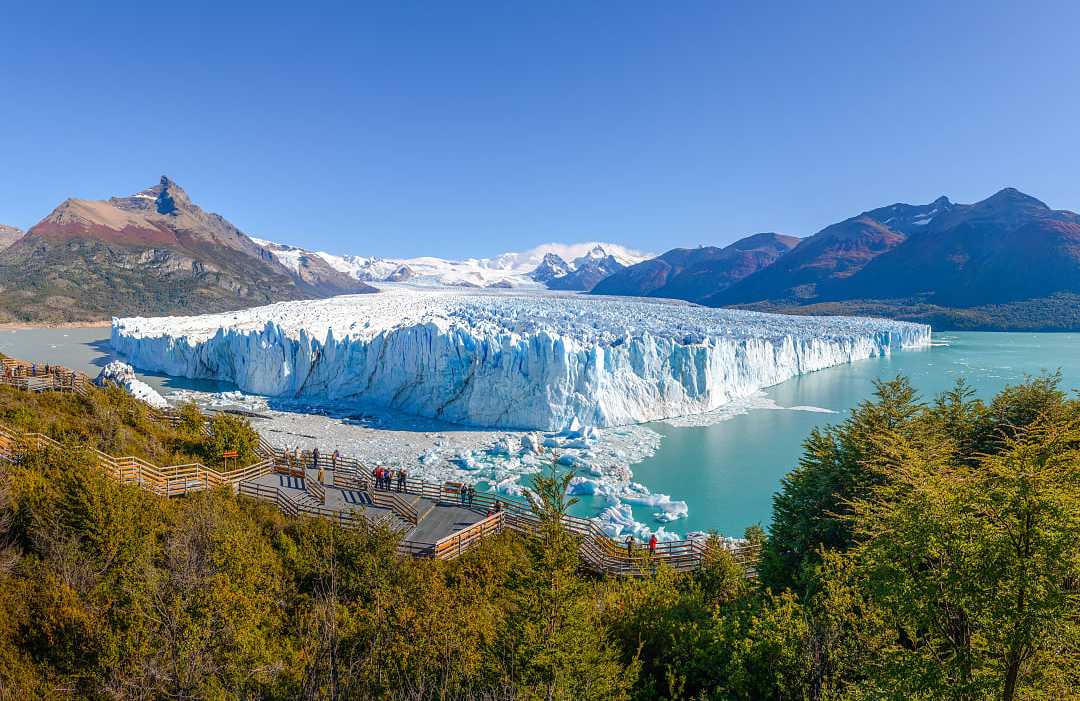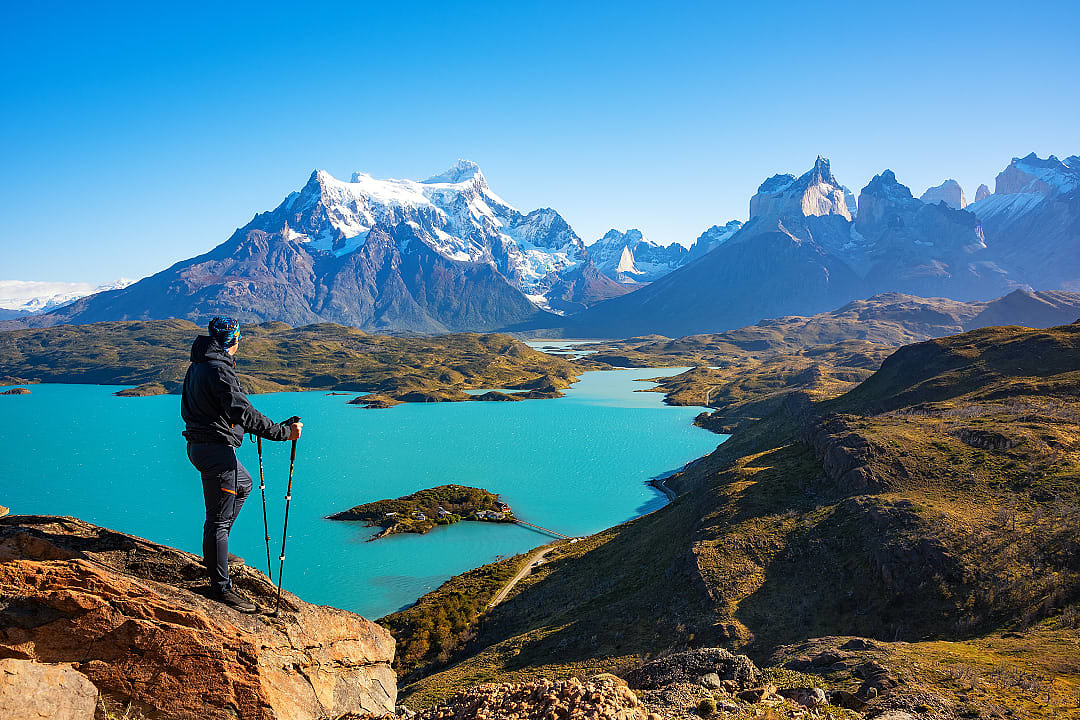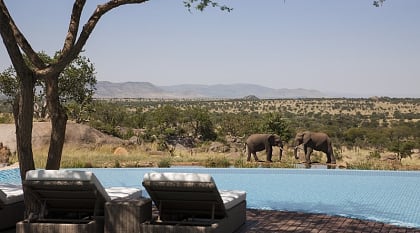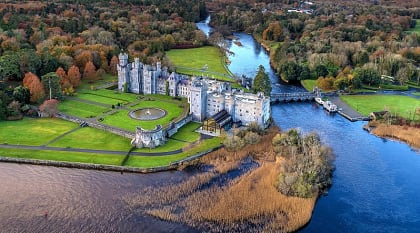Patagonia is a South American region of steppes, desert, semidesert, glacial fjords, and temperate rainforests extending across Argentina and Chile. The area is famous for its diverse landscapes and unique wildlife. There are cultural villages to explore, hiking trails that cross the plateaus and the Andes, and ancient geological formations to admire.
How to Plan a Trip to Patagonia: Frequently Asked Questions

Perito Moreno Glacier in Los Glaciares National Park, Argentine Patagonia
Explore South America’s snowy alpine wonderland comfortably using these answers to frequently asked questions about Patagonia.
The glacial Chilean landscape with its far-flung Argentine villages will introduce you to Patagonian culture and the beauty that unfolds beneath the Andes Mountains. Patagonia is an adventurer’s paradise and a magnificent place to discover on honeymoons, family trips, and multi-generational vacations.
The following information will answer what to consider when planning a trip to Patagonia, giving you a clearer idea of when to visit, what to do, and more.
Where is Patagonia?
Patagonia spans the southern reaches of South America, shared by Argentina and Chile. The region encompasses sections of the Andes mountain range and forms a natural border between the countries along the mountains and splitting the island of Tierra del Fuego. You can travel to Patagonia on tours of Argentina or Chile, on multi-country tours to both, or on dedicated Patagonian trips.
Learn more: Argentina Tours & Vacations • Chile Tours & Vacations • Argentina & Chile Tours
How big is Patagonia?
Patagonia occupies 260,000 square miles of the southernmost tip of South America, encompassing 10% of Chile and 90% of Argentina at a state level.
When is the best time to visit Patagonia?
October through December is the best time to visit Patagonia as the spring and summer months bring warmer weather to its cold, dry climate. The warmer temperatures at this time of the year allow for more comfortable hiking, sightseeing, and other outdoor activities across Patagonia’s distinct natural territories.
If you would like to avoid the crowds that visit from October to December, the best time is in the fall months of March, April, or May. In fall, Patagonia’s green plains burn orange and red in the shadows of snowy summits and bordering electric-blue lakes. Patagonia’s travel rates are also reasonable in the off-season.
You can visit in the winter, from June to August, if you are comfortable with temperatures that can drop to 32°F at night. Patagonian winters are challenging, though excellent for adventure enthusiasts wanting to embrace the region’s dramatic winter on demanding glacial hikes or skiing trips.
Learn more: Best Time to Visit Patagonia
How long should I spend in Patagonia?
Eight to 14 days is typically an ideal window to experience the region’s natural beauty, partake in outdoor activities, and enjoy one or two days at your pace.
There is no right or wrong timeframe for your trip, though we recommend striking a balance between exploration and leisure. With eight to 14 days you can visit iconic rural villages like El Chaltén, hike the glaciers of Los Glaciares National Park, and enjoy adventures in Ushuaia. Another eight to 14-day trip may take you from Argentine to Chilean Patagonia to experience their differences. The longer you stay, the more you can see.
Trips beyond 14 days are excellent for immersive cultural experiences, rigorous adventure tours, or slow-paced senior trips. Whether visiting with family or exploring on your honeymoon, give yourself enough time to appreciate as much of Patagonia as possible.
What are the most popular places in Patagonia?
With sprawling grasslands, vast glacial national parks, and cultural villages, the list is long. Below, we highlight the most popular areas to give you a better idea of where to go:
- Los Glaciares National Park, Argentina
- Ushuaia, Argentina
- El Chaltén, Argentina
- El Calafate, Argentina
- Península Valdés, Argentina
- The Pampas, Argentina
- Torres del Paine National Park, Chile
- Navarino Island, Chile
- Puerto Natales, Chile
- Punta Arenas, Chile
- Tierra del Fuego, Argentine and Chile
What is there to do in Patagonia?
Patagonia is a phenomenal adventure destination with an endless list of outdoor activities. Whether you want to hike from far-flung villages to sculpted glaciers or admire the textures of marble caves, the following list shares our top recommendations:
- Hike across glaciers on casual or challenging trails in national parks to viewpoints overlooking Patagonia’s landscapes
- Cruise to the Perito Moreno Glacier and walk the wooden boardwalk to view the dramatic ice formation
- Veer off the beaten path on a voyage to the Marble Caves, a breathtaking solid marble formation in the Patagonian Andes
- Visit electric-blue lagoons on treks weaving through Patagonia’s granite mountains
- Spend time with colonies of Magellanic penguins, spot pumas, and search for the elusive Andean condor on wildlife tours of Patagonia’s parks and coastline
- Cycle through Patagonia’s diverse landscapes, from rolling hills to mountain peaks, desert plains, and glacial formations
- Explore the remote reaches of Patagonia and immerse yourself in Andean culture in rural villages
- Enjoy Patagonian flavors of cordero al palo, spit roast lamb, filete de guanaco, guanaco fillet, chupe de centolla, Patagonian king crab pie, and more
- Meet gauchos, South American cowboys, at estancias, South American cattle ranches, to learn about their long history in the Pampas
Learn more: Top 7 Things to Do in Patagonia
What kind of trip can I have in Patagonia?
There are so many ways to explore Patagonia and how you design your trip depends on the experiences you want to have and what you would like to see. From couples trekking getaways to family-friendly outdoor adventures, you can kayak between glaciers, ride horses across the Pampas, hike the Andes Mountains, and much more.
Our 7 Best Patagonia Itineraries offer something for every traveler, be it a three-week cross-country trip to Argentine and Chilean Patagonia with your family or a quiet stay in the Patagonian wilderness. In this collection, you will find trip ideas to inspire your custom trip.
Is Patagonia a good place for hiking?
Patagonia is one of the world's best hiking and outdoor adventure places. Desert trails connect the Patagonian steppes to blue lagoons, rainforest paths navigate the lush beech tree canopies, and glacier boardwalks span the frozen formations. With so many excellent hiking trails, the list below can help you select the best options:
- Laguna Torre Hike, El Chaltén
- Perito Moreno Glacier Hike, El Calafate
- Laguna de Los Tres, Los Glaciares National Park
- Huemul Circuit, Los Glaciares National Park
- Nahuel Huapi Traverse, Parque Nacional Nahuel Huapi
- Cerro Castillo Circuit, Cerro Castillo National Park
- W Trek, Torres del Paine National Park
- O Circuit, Torres del Paine National Park
- Cabo Froward, Punta Arenas
- Dientes de Navarino Trek, Navarino Island
Can I explore Patagonia without hiking or trekking?
While Patagonia is an excellent place for hiking and trekking, you can visit the breathtaking region and its glaciers, national parks, steppes, and rainforests without hiking or trekking.
You can spend your trip in Patagonia enjoying the outdoors on scenic road trips through the national parks. New roads allow you to navigate the dramatic landscapes efficiently while offering cinematic beauty. The towns and villages, like El Chaltén and El Calafate, have spectacular views, and you can explore cultural sites and culinary hotspots along the way.
You can also spot wildlife on wildlife safaris, explore the regions on horseback, sail past glaciers on cruise ships, and more if you do not wish to hike or trek.
What wildlife can I see in Patagonia?
Patagonia’s diverse environments of steppes, deserts, plains, glaciers, and mountains are home to all sorts of fascinating wildlife. Here, we list what to look out for and where:
- Southern right whales and orcas, Península Valdés
- Magellanic penguins, Punta Tombo National Reserve
- King penguins, Tierra del Fuego
- Humpback whales, Francisco Coloane Marine Reserve
- Condors, guanacos, and pumas, Torres Del Paine National Park
- South Andean deer, Cerro Castillo National Park
What accommodations are available in Patagonia?
From spa resorts nestled in national parks to lakeside lodges, eco-camps with glamping options, and authentic estancias and haciendas, there are many types of accommodations in Patagonia.
The accommodation options available to you offer different ways to experience Patagonia. Estancias and haciendas are traditional, and you can learn about South America’s cowboy culture on horseback excursions and during family dinners with your hosts. Spa resorts and lakeside lodges provide privacy, with backdrops of Patagonia’s blue waters, white-tipped mountains, and emerald plains, while glamping is excellent for adventurers.
Your Zicasso travel specialist can offer suggestions of which accommodations may be best for your trip, ensuring you take advantage of the experiences that await you and the areas you visit.
How do I travel around Patagonia?
Patagonia is a rugged region with remote towns and villages, yet several reliable transportation options are available. For example, Patagonia's most popular modes of travel are planes, private cars, rental cars, buses, and boats.
Traveling by air is the quickest way to reach parts of Patagonia from Argentina and Chile or between the two countries. For example, there are airports in Patagonia’s popular destinations, like El Calafate in Argentina and Punta Arenas in Chile, that can connect you from one region to another.
While exploring Patagonia, buses are reasonable and surprisingly comfortable. Cars are also great options for flexibility, privacy, or road trips, as highways and roads offer routes through Patagonia and its national parks. In addition, boats are one of the most comfortable and exciting ways to cross Patagonian waters on glacier cruises, while cycling is popular among adventure enthusiasts.
Is Patagonia a good destination for families?
With its remarkable volcanic, glacial, and forested landscapes, as well as endless outdoor experiences, including hiking, kayaking, sailing, and more, Patagonia is a sensational destination for families of all ages.
Families flock to Patagonia, choosing to immerse themselves in nature, and their reward is an adventure destination like no other. There are ice-trekking tours on the Perito Moreno Glacier for parents with older teens, cable cars soaring above forest canopies for those with young children, and cruises for families who want to visit Patagonia without hiking.
The list of family-friendly activities in Patagonia knows no bounds. You can sip craft beer as your children waffle down ice cream after a casual hike through the mountains to glacier viewpoints. You can ride horses in the Pampas, watch Magellanic penguins waddle along the shoreline, and white-water raft through the rainforests.
Is Patagonia suitable for senior travelers?
Senior trips to Patagonia are not only possible, but unforgettable, as Patagonian lodges cater to travelers of all ages and hands-on guides can show you the vast beauty on comfortable hikes and tours.
Luxury Patagonian safaris in the region’s glacier national parks are some of the easiest and best ways to discover the cinematic scenery of snow-capped mountains, reflective lagoons, and lush rainforests. Casual hikes are also popular among senior citizens, while challenging trails appeal to active seniors. Beyond outdoor experiences suitable for all ages, you can experience Patagonian culture at estancias, cattle ranches, or around rural towns.
Traveling with a Patagonian destination expert, you can easily adjust your itinerary on the fly to cater to your preferences, whether you wish to spend an afternoon around the fire at your lodge or enjoy a sunset cruise on a lavish yacht.
Is Patagonia suitable for couples or honeymooners?
Adventure-loving couples will find plenty to adore in Patagonia, one of South America's best active travel destinations for romantic trips in nature or honeymoons in national parks.
The rugged alpine mountains, shimmering bodies of water, and dewy rainforests are enchanting. These scenes backdrop trips across the region, inviting couples and honeymooners on hikes to capture incredible photography. A Patagonian cruise is a must for couples' getaways as there is nothing like viewing the glacial formations from the privacy of your deck as you sip cocktails and enjoy Patagonian cuisine.
You can also taste whisky with ice chipped from a glacier, enjoy treatments, yoga, or a dip in your private plunge pool in the Patagonian wilderness, where you are able to discover, on safaris, the wildlife that inhabits remote areas.
What is the food like in Patagonia?
Patagonian dishes deliver intense, rich flavors, and their presentation is vibrant and colorful. From seafood dressed in spices to meat slathered in sauces and delicate sides often paired with wine, here are some of the most popular dishes and drinks to try:
- Cordero al palo, spit roast lamb
- Filete de guanaco, guanaco fillet
- Chupe de centolla, Patagonian king crab pie
- Empanada de cordero, lamb empanadas
- Chimichurri with meat
- Pisco sours, a Peruvian cocktail
- Argentine asado, barbecued meat
- Maté, traditional South American tea
Is Patagonia safe to visit?
Patagonia is an incredibly safe region. Violent crime against tourists is scarce and locals are very friendly to foreign visitors, making the area perfect for family trips, couples vacations, solo travel, senior tours, and more.
There are several safety tips to remember when hiking or exploring the Patagonian outdoors. Trails range in difficulty and you should be upfront about your fitness levels. Your guide will then be able to determine the safest routes for you. If you are an active explorer on a self-guided hike, bring plenty of water and appropriate hiking equipment. On Patagonian walks, altitude sickness is not a concern.
Some travelers express concerns regarding their safety on Patagonian safaris, but you should not experience any close encounters with dangerous wildlife. Most animals, like guanaco and deer, are tame, while predators like pumas are elusive. On puma safaris, your tour guide will help you search for these magnificent animals while keeping a safe distance.
When traveling to Patagonia in winter, fireplaces in insulated accommodations will keep you warm between outdoor tours and experiences. Also, food and water are clean, though you will have access to purified water at your hotels.
What language do they speak in Patagonia?
Patagonia’s official language is Spanish, in Argentine and Chilean Patagonia.
Some indigenous communities speak other languages, like Mapuche, and there is even a Welsh-speaking community in the Chubut Province. That said, English is widely spoken in the areas you are likely to visit and your guide will be able to translate if there are any communication barriers.
What vaccinations do I need to travel to Patagonia?
Depending on where you go in Patagonia, there are certain vaccinations the CDC recommends. You can find these through CDC Argentina Vaccination Information and CDC Chile Vaccination Information.
If you want further vaccination advice, we recommend chatting with a Zicasso travel specialist and consulting your doctor or travel nurse before your trip.
Where do I fly in to visit Patagonia?
Several international airports service Argentine and Chilean Patagonia, and your Patagonia travel specialist will help you select the most suitable for your itinerary. The following airports represent the most common for Patagonia vacations:
Argentine Patagonia:
- San Carlos de Bariloche Airport (BRC), Bariloche
- Aeropuerto de Esquel (EQS), Esquel
- Comandante Armando Tola International Airport (FTE), El Calafate
- Malvinas Argentinas Ushuaia International Airport (USH), Ushuaia
Chilean Patagonia:
- Arturo Merino Benítez Airport (SCL), Santiago
- Teniente Julio Gallardo Airport (PNT), Puerto Natales
- Presidente Carlos Ibáñez International Airport (PUQ), Punta Arenas
What currency does Patagonia use?
The official currency of Argentina is the Argentine peso ($) and the official currency of Chile is the Chilean peso ($). Depending on which side of Patagonia you visit, you will require one, the other, or both.
There are no ATMs in the rugged wilderness and electronic payments are not always possible in certain areas. Therefore, we recommend traveling with the appropriate currency in cash.
You should, as always, carry established credit cards like Visa, Mastercard, or American Express in case of emergency, as well as some US dollars in cash, as some establishments accept foreign currency at a better exchange rate.
How can Zicasso help me plan my trip to Patagonia?
From creating your itinerary to organizing your accommodation and booking your tours, a Zicasso travel specialist can help plan the details of your Patagonian trip. To discover what is possible, view our Patagonia Tours, where you can find recommendations. Working with a travel specialist, you can customize these sample trips further until you are satisfied with your itinerary.
To start planning a tour from our collection or create your custom itinerary with a travel specialist, complete a Trip Request. Here, you can provide your destination, share travel ideas, determine your duration, and set an estimated budget. After submitting your form, our Travel Care team will be in touch to discuss your plans and connect you to a Patagonia travel specialist.
Your travel specialist will be available to plan every trip detail, helping you navigate the possibilities and arranging a stress-free experience in Patagonia. They are also available for the duration of your trip to help with on-the-fly changes or in case of emergency, giving you peace of mind from the moment you embark until you return home.
Learn more: How to Plan Your Zicasso Trip in 4 Easy Steps • How to Plan Your Zicasso Trip Budget in 3 Easy Steps
Where can I find recommended itineraries for my trip?

Escape to the stunning alpine slopes of Patagonia with our Patagonia Tours. They reveal the region’s untouched wilderness, gorgeous glaciers, and distinct Argentine and Chilean culture. Trek across expansive glaciers or enjoy the vast pampas on horseback on a custom trip with a dedicated travel specialist.
If you would like more inspiration for trips to Patagonia that pass through Argentina or Chile, explore our Argentina & Chile Tours.






